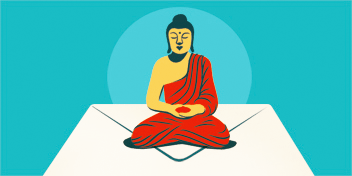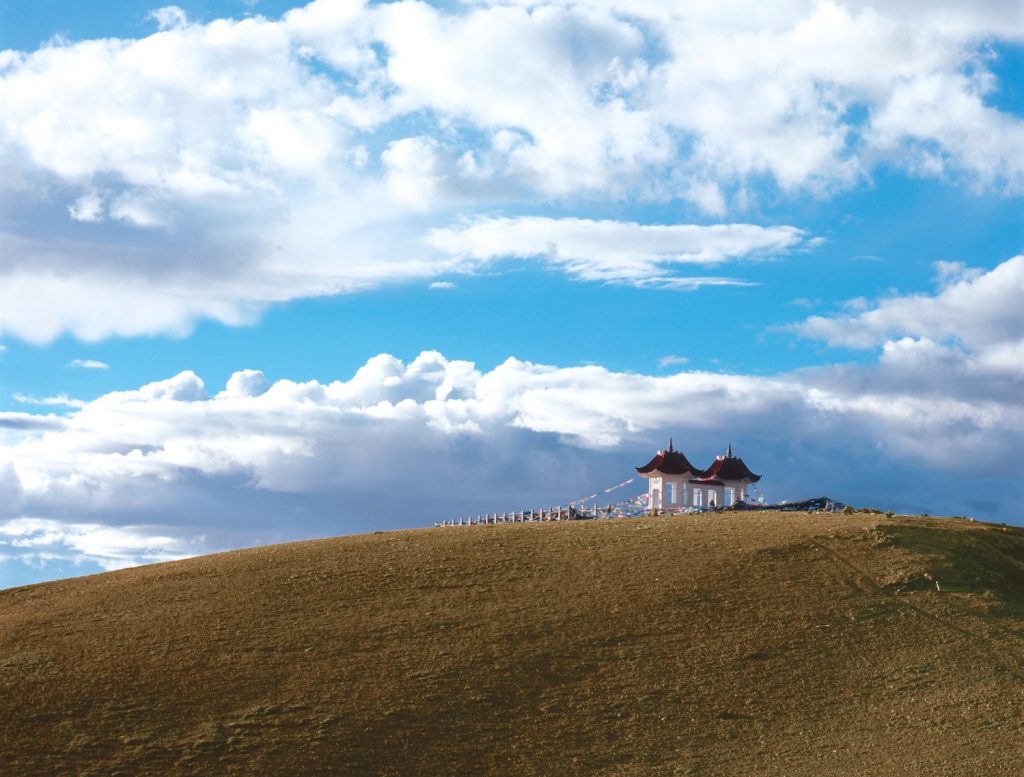The Sources of Buddhist Traditions is a monthly column from three of the major digital resources for Buddhist research, texts, and translation: Buddhist Digital Resource Center, The Treasury of Lives, and 84000: Translating the Words of the Buddha. Focusing on stories, texts, translation, and teachers, the series will illuminate aspects of Buddhist practice, thought, and tradition.
Even as a mother protects with her life
Her child, her only child,
So with a boundless heart
Should one cherish all living beings—Karaniya Metta Sutta, trans. by The Amaravati Sangha
In Tibetan Buddhism, a tulku is a person who as early as infancy is identified as a reincarnation of a deceased lama and trained to fulfill his (or rarely, her) destiny as a high-level bodhisattva, a saint who will dedicate his or her every moment to the wellbeing of all sentient beings. Trained from a young age to serve the same position as his predecessor, the child leaves his family to live at a monastery, often never to sleep under the same roof as his family again. Tulku narratives usually try to avoid the appearance of a child wrenched from his mother’s arms, emphasizing what an honor it is to give birth to a teacher who will benefit others and casting the mother as a great bodhisattva who lovingly gifts her offsprings to the world. Her love is as it should be—not just for her child, but for all beings.
As a parent I cannot relate to this, even with my faith in the dharma and the sangha. I’m not alone, either, and the accounts we have of Tibetan mothers resisting demands to give up their children offer us an opportunity to consider a more nuanced and deeply felt response to this cultural expectation.
Take the astonishing story of Konchok Peldron, grandmother of Tulku Urgyen, who is considered to have been one of the greatest Dzogchen masters of his time. In Tulku Urgyen’s remarkably human memoir, Blazing Splendor, he recounts how his grandmother refused to surrender two of her children, Tulku Urgyen’s father and an uncle, after they had been identified as tulkus. She was a woman of great faith and accomplishment whose family supported monasteries and Buddhist practice. But when the lamas came to her door, she fought like hell to keep her children.
Konchok Peldron was born in the 1850s, the daughter of the great treasure-revealer Chokgyur Lingpa. Her mother, Dechen Chodron, known to people as Degah, was a sister of Chokgyur Lingpa’s disciple Barwai Dorje, whose reincarnations are known as the Bardor Tulkus. She is credited with preserving the liturgical melodies of Chokgyur Lingpa’s revelations and passing them on to her children and other lineage holders. Tulku Urgyen describes his great-grandmother, Degah, as wrathful and obstinate, a powerful woman capable of holding her own against the demands of her famous husband. She no doubt provided her daughter with a model for standing up to men.
Konchok Peldron married a man named Orgyen Chopel, a son of a powerful Nangchen family by the name of Tsangsar, which controlled the Barom Kagyu monasteries Lhalam, Lachab, and Namgon. Tibetan Buddhist monasteries traditionally are run either by family line, incarnation line, or, as in the case of the Tsangsar monasteries, a combination of both. All four of Konchok Peldron and Orgyen Chopel’s sons were identified as reincarnations, and all became prominent lineage holders of Chokgyur Lingpa’s treasures. The eldest, Samten Gyatso, was identified as the head of Lhalam monastery and was taken there at the age of five to be trained. In his book, Tulku Urgyen does not relate how Konchok Peldren felt about losing her first child to Lhalam. Installing a son as a throne holder of a family monastery would have been expected, and her husband’s connection to the monastery would have afforded her opportunities to spend time with him. But when, several years later, monks from another family monastery, Namgon, came to claim her second son, Chime Dorje, Konchok Peldren refused.
As told by Tulku Urgyen in Blazing Splendor, the monks arrived during the funeral period for Konchok Peldron’s mother, Degah. Konchok Peldron greeted the monks respectfully but asked that they return another time in deference to her family’s mourning. She told them that she would honor the designation of her son as a tulku, made by the Fourteenth Karmapa himself, but she asked for her family to be left whole until the funeral services were over.
A lama responded with condescension: “There is only one thing for you to say, and that is ‘yes.’ I will not accept any other answer from you.” The monastery was two days’ away by horse, and the lama refused to leave and return. Konchok Peldron maintained an even temper, repeating her promise to give up her child, but she chided the lama for his rudeness and asserted her right as a mother to keep her child. As the lama continued to insist, the conversation became increasingly hostile, and even included the two angrily passing back and forth a katak, the ritual greeting scarf, which Konchok Peldron repeatedly refused to accept from the lama. In the end she declared, “Now I’m absolutely certain: I won’t accept your white scarf! I shall never hand over my child to someone like you! As he is my child, he is in my care! You will never get him—so you might as well get out!”
The lama and his attendants left in a huff, but they camped nearby, and despite the precautions Konchok Peldron took to guard her son, soon after the funeral she traveled to another monastery and found herself surrounded by twenty-five monks on horseback. They demanded she hand over her three-year-old. Her attendants, their hands on their knives—this being the Tibetan province of Kham, where everyone carried knives—asked her if she wanted them to attack. Not wanting violence, she submitted, and watched as a monk took her child, wrapped him in robes, and rode away.
Konchok Peldron’s husband—whose family was the patron of the monastery that took their son—was not inclined to demand the child be returned. Disgusted, Konchok Peldron left the Tsangsar estate and moved to her father’s monastery, Tsike, then headed by Tsike Chokling, one of two reincarnations of Chokgyur Lingpa. The great Sakya lama Jamyang Khyentse Wangpo, who had been a close collaborator with Chokgyur Lingpa, later identified Konchok Peldron’s youngest son as the reincarnation of her own brother, Wangchuk Dorje, and as a result he was thereafter trained at Tsike.
Not long after Chime Dorje had been abducted and brought to Namgon, lamas from yet another monastery (Tulku Urgyen does not tell us which one) came for her third child, Sang-ngak, who, like his two elder brothers, had also been designated by the Fourteenth Karmapa as an incarnation. This time Konchok Peldron successfully held them off. Noting that her youngest had been claimed by Tsike, she declared, “All I have left is Sang-ngak and I need a son in the house to help me. Now you’ve come for him—are you going to act like brutes and take him by force?” The monks, without the backing of a strong monastery, retreated and did not return.
Five years later, Chime Dorje, now eight years old, asked to see his mother and was allowed to visit her at Tsike. When the monks left, Konchok Peldron refused to allow them to take Chime Dorje with them.
The lama of Namgon went to Pelpung Monastery, the dominant Kagyu monastery of the region, and submitted the case to the Eleventh Tai Situ, Pema Wangchuk Gyelpo. They argued that because the child had been selected by the Karmapa, the family had to surrender him. But Tsike Chokling argued persuasively that, as Tulku Urgyen put it, “a child is born from its mother and there is no tradition that allows for taking a child without its mother’s consent.”
Konchok Peldron kept her child, and as a result Chime Dorje never formally became a lama. He did mature into an accomplished practitioner and a lineage holder of the treasures of Chokgyur Lingpa, but he was a wild youth who only settled down in his adult years.
In his memoir, Tulku Urgyen does not criticize his grandmother for keeping his father at home. After all, had Chime Dorje gone and become a celibate monk, Tulku Urgyen would not have been born, and the world would have been denied one of the last century’s greatest Buddhist teachers. Instead, he praises his grandmother extensively, calling her extraordinary and accomplished and telling stories of lamas seeking her out for blessings. He states that relics were found in her cremation ashes. But his praise isn’t a given.
Alongside the oft-quoted passage from the Metta Sutta that uses a mother’s love as a model for a bodhisattva’s love for all sentient beings, other scriptures depict a mother’s love in a negative light: an illustration of samsaric attachment. We are all bound by our desires like a mother loves her children, and we will not easily give them up, no more than a mother would give up her child, this view says. From this perspective, one might be tempted to fault Konchok Peldron for contesting the expectations placed on her—to judge her love as small because she refused to offer her child to the world. But this would be a mistake. A literary metaphor is not an instruction for everyday life. Regardless of how scriptures employ motherly love to make a point, an actual mother has the right to refuse to surrender her child. Tulku Urgyen viewed Konchok Peldron as a bodhisattva: a holy woman who raised four teachers who went on to spread the treasure teachings of Chokgyur Lingpa, and a mother who was also willing, at the right moment, to contest authority, for the love of her children.
♦
This essay and linked biographies were created with support from the National Endowment for the Humanities. Any views, findings, conclusions, or recommendations expressed do not necessarily represent those of the National Endowment for the Humanities.
Thank you for subscribing to Tricycle! As a nonprofit, we depend on readers like you to keep Buddhist teachings and practices widely available.

